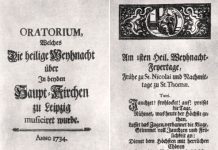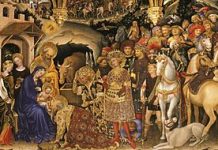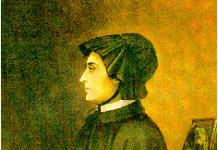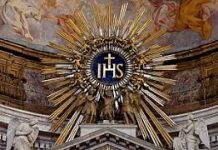A strange myth has evolved through recent centuries alleging that the Catholic Church was forever the enemy of science, and that it set out during the Middle Ages to strangle scientific thought in its cradle. This is a radical distortion of true history. The case of Galileo, usually cited as an instance of suppressing science, was more a personal clash between a proud pope, Urban VIII, and an arrogant scientist, than it was part of a supposedly centuries-long Catholic policy of suppressing scientific thought. The details of that clash rarely seem to be known or acknowledged (or they have been deliberately ignored) by Church critics untutored in history. The real facts of the story may make for interesting, perhaps even sardonic observations about the folly of human pride, but they certainly do not prove that the Church as a matter of policy was hostile to science. As physicist Stephen M. Barr remarks in Modern Physics and Ancient Faith: “The fact is that the attitude of the Church has overwhelmingly been one of friendliness to scientific inquiry. Long before Galileo, and continuing to the present day, one can find examples in every century, not merely of church patronage of science, but of important scientific figures who were themselves monks, priests, and even bishops.”
It is useful first to consider why modern science emerged from medieval Catholic culture. We look in vain for signs of that rise in the history of the major civilizations that were contemporary with the Middle Ages of Europe. Why science should have evolved so successfully out of the medieval milieu is a thesis question in need of a book, or several books, to answer it. Suffice it to briefly suggest here that the Catholic mindset of the medieval era in both philosophy and theology was distinctly analytical, and certainly had been at least since the days of St. Augustine through St. Thomas Aquinas. One need only reflect on Augustine’s dazzling analysis of the nature of time in Book XI of his Confessions, to see that he had fertilized a seed which could grow through the centuries toward Einstein’s pithy remark: “The only reason for time is so that everything doesn’t happen at once.”
Historical Factors
The origins of modern science may be traced back centuries before Galileo. The period of the Middle Ages from the 5th to the 15th century was a period of recovery from horrendous assaults against Western Civilization. The first misery suffered was the collapse of the vastly bloated Roman Empire in the 5th century. Then came the invasions of the Huns, the Vikings, the Mongols, and the Muslims that threatened to bring an end to the rise of Christianity. From the East, Islam was set to triumph, and did subdue much of Spain. If not for the brilliant military tactics of the French general Charles (“the hammer”) Martel, we might all be Muslims today. The medieval Church encouraged the will and wherewithal by which the West could recover from military assaults. Monasticism was the single institution best equipped to manage the recovery of both philosophical and scientific thought long delayed by the desperate business of warding off invading armies and surviving the plague of the Black Death that is estimated to have killed half the population of Europe. In those days science would not have been suppressed, because it was on the back-burner of existential priorities.
Even while Europe was struggling to survive, the Church was quietly but steadily building the infrastructure by which future scientific advances would be made possible. Most important of all, the Church fostered the university system that would later spread throughout Europe and become the seedbed of scientific thought in ages to come. Again, the medieval Church sponsored the hospital system that in future centuries would produce enormous gains in medical science. The Crusades made possible access to the ancient writings of Aristotle, whose scientific work (though somewhat flawed) would eventually revive interest in scientific thought. Finally, a Catholic named Johannes Gutenberg (1400-1468) would invent the printing press, by which scientific writings could be rapidly reproduced and transmitted to scholars everywhere, thus providing the medium by which scientific thought could expand exponentially without end. Five of the most important Catholic contributors to scientific thought are worth briefly mentioning here.
Roger Bacon and William of Ockham
The dominant intellectual spirit of the 13th century was for theology first and philosophy second. In England there lived a Franciscan monk named Roger Bacon (1220-1292). England has always been at the forefront of the movement toward empirical thought and Bacon spearheaded that movement perhaps more vigorously than anyone else. Unimpeded by the dominance of the Scholastic schools in France and Italy, Bacon was free to follow his own inquiries in his own way. Pope Clement IV was the most notable supporter of his writings. The historian Will Durant in The Age of Faith documents that Bacon agreed with the Dominican monk (later bishop) St. Albertus Magnus, who emphasized the connection between mathematics and natural science. Bacon advocated the view (more thoroughly developed three centuries later by his English namesake Francis Bacon) that all scientific knowledge should be verified by experiment. A thinker with great imagination, Bacon anticipated in the distant future the invention of machines that roughly suggest our modern cars, airplanes, and submarines. Most important of all, by way of his fascination with the science of optics, he pondered the principle of lens magnification that would lead centuries later to the invention of the telescope and the subsequently rapid advances in astronomy.
After Roger Bacon comes William of Ockham (1287–1347), a fellow English Franciscan monk. Not a scientist in his own right (more so a logician) William would lay down a rule that became one of the foundation principles of modern science. According to William, every scientific explanation should limit itself (cut itself down to) the simplest reasonable terms, for simplicity alone allows experiment and confirmation. The principle is also known today as the Law of Parsimony, or Occam’s Razor. William’s insight, perhaps more than any other, gave rise over the centuries to modern scientism, which is the view that natural laws must be explored and explained without recourse to metaphysics, and the supposition that scientific knowledge alone is real knowledge. For example, God must not be invoked to explain the orbits of the planets. Nor can the providential power of God be invoked to explain biological evolution, since evolution can only be governed by the laws of chance and probability. It is not a far stretch to infer that William unwittingly provided a scientific principle that over time would give rise to the popularity of atheism among modern scientists. Even so, the greatest of scientists from Isaac Newton to Albert Einstein were not atheists.
Nicholas Copernicus
The Polish astronomer Copernicus (1473-1543) was definitely much involved in the affairs of the Church (he was a canon) along with his studies in astronomy. Though there is no record that he was ordained a priest, he was nominated by the King of Poland to fill the bishopric of Ermland. The main consequence of his work in astronomy was that he reversed the ancient Ptolemaic concept of the universe (which had the sun, the moon, and the planets revolving about the earth) and argued the principle of planetary motions around the sun (heliocentrism), a theory that Galileo would later take up and advance. Bishops and Cardinals urged Copernicus to submit his discoveries to the Pope. His greatest work, Six Books on the Revolutions of the Celestial Orbits, was dedicated to Pope Paul III and was treated with much respect by the Church, but very much opposed by Martin Luther and the Protestants as decidedly unbiblical. In reply Copernicus said: There may be babblers, wholly ignorant of mathematics, who dare to condemn my hypothesis, upon the authority of some part of the Bible twisted to suit their purpose. I value them not, and scorn their unfounded judgment.
Gregor Mendel
Many Catholic scientists, mathematicians, and inventors appear in later centuries, including Descartes and Pascal. The Jesuits seem to have been especially prolific in providing breakthroughs in science and mathematics during the Renaissance. By the middle of the 19th century Darwin’s theory of evolution was all the rage. Unfortunately for Darwin, the theory was able to garner wide support among fellow biologists but not experimental verification. About the same time a Catholic monk in Austria, the botanist Gregor Mendel (1822-1884), was quietly laying the foundation principles for a new science of genetics that would dominate the 20th century. His experiments with several generations of pea plants proved certain laws of heredity. Mendel’s studies, though published, were mostly ignored. He abandoned his scientific studies and in later life became the abbot of his monastery. Long after his death the new science of heredity revived after his work was rediscovered.
Spurred on by the invention of powerful microscopes, scientists discovered DNA, the building blocks of life. The science of genetics also produced a quandary for the Darwinists. If, as logic demands, evolution began with a single-cell creature who started the whole chain of evolution from the simplest to more advanced forms of life, there was no way to explain how life evolved from inanimate matter, since by definition evolution requires the change from one life form into another. The great complexity of DNA in a single-cell organism mitigates against the likelihood that the laws of chance could act on inanimate matter, producing a complex living cell.
In 1953 James Watson and Francis Crick, the discoverers of the complex double helix structure of DNA, for which they shared a Nobel Prize, knew this. They knew it so well that Crick despaired of explaining how that complex structure could evolve from inanimate matter without being intelligently directed to evolve as it did. Since Crick was an atheist, there was no way out of this dilemma other than to argue, as in fact he did, that panspermia (the seeds of life) are everywhere in the universe, and that these seeds might have been transported by spaceship from afar to our hospitable planet where, once deposited, they would evolve as they did. It mattered not to Crick that if this happened billions of years ago after water first appeared on the planet, it could never be proven by scientific means. The theory of panspermia was a triumph of wishful thinking over common sense, since there could be no explaining how the advanced creatures who sent their spaceship to earth came themselves to evolve from simple molecules of inanimate matter. It seems that the science originated by Gregor Mendel had, in a curious way that even Mendel could not have anticipated, challenged the logic of today’s atheist biologists, like Richard Dawkins for example, who wrongly claim that Darwin’s theory of evolution made atheism respectable.
Georges Lemaitre
Perhaps the most spectacular incident involving a Catholic scientist occurred in the early part of the 20th century. Georges Lemaitre, a young Jesuit priest and brilliant mathematician, was examining the mathematical equations of Einstein’s theory of relativity when he discovered an error of monumental significance. Correcting Einstein’s math meant encountering a phenomenon that nobody in those days expected. The dominant view of astronomers into the 20th century had been that the universe was infinite and eternal. Einstein accepted this view, and scientists generally were comfortable with it, since, as Occam’s Razor required, it removed any need for God to complicate the equations.
Now for some scientists, the troubling conclusion to be drawn from Lemaitre’s discovery was that the universe had to have a beginning in time. In other words, it was born, like a cosmic egg, something very small that over billions of years would expand into its present vast space. Calculations indicate that the backward measure of universal time comes to a stop close to fourteen billion years ago, on “a day without yesterday.” The universe is neither infinite nor eternal. For some scientists this was suspiciously close to the book of Genesis where an account is given of the creation of the universe. To complicate matters further, as the theory came to be explored decades after Lemaitre’s discovery, it was revealed that the early universe was flooded with an intense explosion of light and heat beyond anything the universe has seen since (now called the Big Bang). This light-creating event was described by atheist astronomer Carl Sagan in his book Cosmos. What Sagan understandably does not comment on is the relative proximity of this scientific revelation to what we are told in Genesis 1:3, where the first words of creation out of God’s mouth are: “LET THERE BE LIGHT.”
Reactionary Scientism
Almost immediately, atheist astronomers sought an escape hatch from the possibility that the universe was created. Following Occam’s Razor, anything (ANYTHING BUT A CREATOR GOD!) had to be considered. Immediately the alternative options were lined up. What if the Big Bang could be followed by a Big Crunch, whereby the universe, in reverse gear, diminished to the size of its original primordial firecracker, then exploded once again; on and on throughout eternity? Was that possible? Possible, but there was no proof to argue it, and scientific ideas are supposed to have proof. Then again, what if our universe was born out of another universe, and that one out of another, ad infinitum? Well, again no proof. So it would seem we are still left with only one sure fact: the universe was created. Not only was it created, but apparently there is no convincing scientific explanation for why or how it was created. Nor, to repeat, is there any reasonable explanation why earth is populated by organisms too complex to have appeared, even in their most primordial state as one-cell creatures, without being designed to manifest such complex cellular structure.
Scientism, or the worship of scientific knowledge, is a religion despite its pretense of being superior to religious knowledge. It is a religion because the tenets of scientism are based ultimately on faith. What faith? The faith that there is no legitimate knowledge other than scientific knowledge. This can never be proven using scientific evidence; it is an unproven assumption; therefore it is an article of faith. Another aspect of scientism is the belief (again not provable with scientific evidence) that there is no God because there is no scientific way to detect God. Yet another article of faith: there is no soul, because there is no scientific way to detect such a thing. And another: we don’t need a Creator because the universe is eternal; but how could you ever prove this?
The above articles of faith essential to scientism are as prolific as the articles of faith in any other religion. It does no good for the champions of scientism to argue that extraordinary claims (such as that there is a God) require extraordinary evidence. That evidence, which they summarily dismiss, was offered in the life, death and miraculous resurrection of Jesus Christ. But when asked for the extraordinary evidence of the extraordinary claim that there is no God, atheists are extraordinarily silent. No such evidence exists.
Finally, the serious religious implications of science might be too madcap for the apostles of scientism to ponder. The agnostic astronomer Robert Jastrow, mulling over the Big Bang theory of our created universe, seems to have put his finger on the pulse of the matter in his book God and the Astronomers: The astronomer has scaled the mountains of ignorance; he is about to scale the highest peak; as he pulls himself over the final rock, he is greeted by a band of theologians who have been sitting there for centuries.











